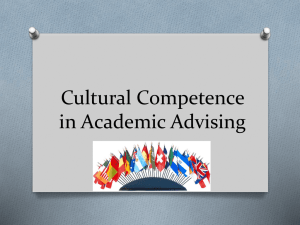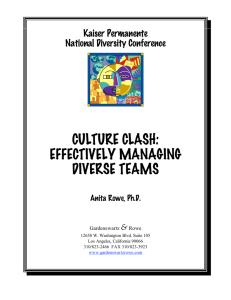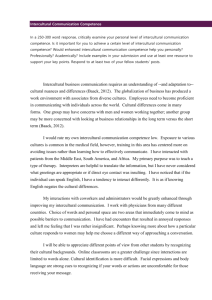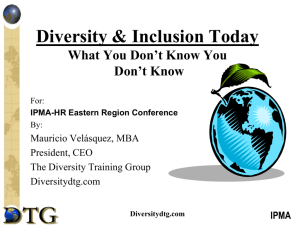Work Force Diversity Resources
advertisement
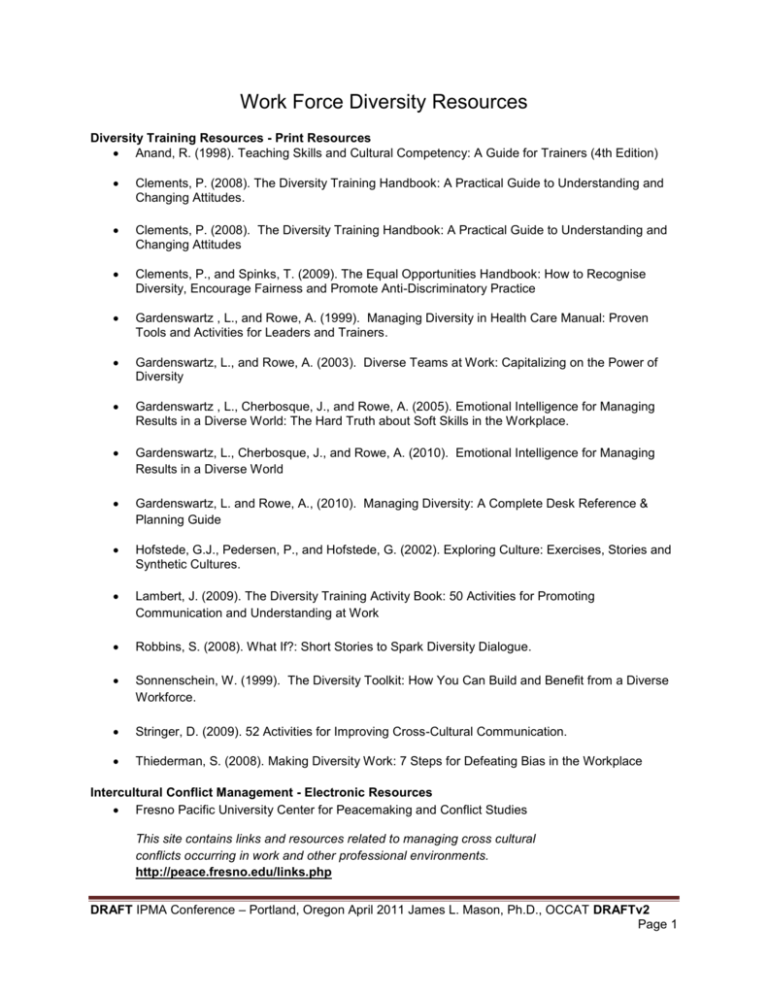
Work Force Diversity Resources Diversity Training Resources - Print Resources Anand, R. (1998). Teaching Skills and Cultural Competency: A Guide for Trainers (4th Edition) Clements, P. (2008). The Diversity Training Handbook: A Practical Guide to Understanding and Changing Attitudes. Clements, P. (2008). The Diversity Training Handbook: A Practical Guide to Understanding and Changing Attitudes Clements, P., and Spinks, T. (2009). The Equal Opportunities Handbook: How to Recognise Diversity, Encourage Fairness and Promote Anti-Discriminatory Practice Gardenswartz , L., and Rowe, A. (1999). Managing Diversity in Health Care Manual: Proven Tools and Activities for Leaders and Trainers. Gardenswartz, L., and Rowe, A. (2003). Diverse Teams at Work: Capitalizing on the Power of Diversity Gardenswartz , L., Cherbosque, J., and Rowe, A. (2005). Emotional Intelligence for Managing Results in a Diverse World: The Hard Truth about Soft Skills in the Workplace. Gardenswartz, L., Cherbosque, J., and Rowe, A. (2010). Emotional Intelligence for Managing Results in a Diverse World Gardenswartz, L. and Rowe, A., (2010). Managing Diversity: A Complete Desk Reference & Planning Guide Hofstede, G.J., Pedersen, P., and Hofstede, G. (2002). Exploring Culture: Exercises, Stories and Synthetic Cultures. Lambert, J. (2009). The Diversity Training Activity Book: 50 Activities for Promoting Communication and Understanding at Work Robbins, S. (2008). What If?: Short Stories to Spark Diversity Dialogue. Sonnenschein, W. (1999). The Diversity Toolkit: How You Can Build and Benefit from a Diverse Workforce. Stringer, D. (2009). 52 Activities for Improving Cross-Cultural Communication. Thiederman, S. (2008). Making Diversity Work: 7 Steps for Defeating Bias in the Workplace Intercultural Conflict Management - Electronic Resources Fresno Pacific University Center for Peacemaking and Conflict Studies This site contains links and resources related to managing cross cultural conflicts occurring in work and other professional environments. http://peace.fresno.edu/links.php DRAFT IPMA Conference – Portland, Oregon April 2011 James L. Mason, Ph.D., OCCAT DRAFTv2 Page 1 University of Massachusetts - The National Center for Technology and Dispute Resolution This site contains an index of electronic, bibliographic and other resources related to online dispute resolution. http://www.odr.info/library.php LeBaron, Michelle. "Cross-Cultural Communication." Beyond Intractability. Eds. Guy Burgess and Heidi Burgess. Conflict Research Consortium, University of Colorado, Boulder. Posted: July 2003 http://www.beyondintractability.org/essay/cross-cultural_communication/ LeBaron, Michelle. "Communication Tools for Understanding Cultural Differences." Beyond Intractability. Eds. Guy Burgess and Heidi Burgess. Conflict Research Consortium, University of Colorado, Boulder. Posted: June 2003 http://www.beyondintractability.org/essay/communication_tools/. Intercultural Conflict Management – Print Resources LeBaron, Michelle. Bridging Cultural Conflicts: New Approaches for a Changing World. San Francisco: Jossey-Bass Publishers, April 2003. This work presents strategies for bridging the gap between culture and conflict. Becoming skillful at this task is increasingly important to people in all realms of society as the world becomes more integrated. The work illustrates many of the proposed principles through stories."Working on Common Cross-cultural Communication Challenges." , 1900 Available at: http://www.wwcd.org/action/ampu/croasscult.html Lusting, Myron and Jolene Koester. Intercultural Competence: Interpersonal Communication Across Cultures, 4th Edition. Allyn & Bacon, July 8, 2002. This book discusses cultural differences that exist with respect to communication styles. The book focuses on practical considerations for why we should attempt to understand people Novinger, Tracy. "Intercultural Communication." In Intercultural Communication: A Practical Guide. Austin, TX: University of Texas Press, March 2001. This essay examines the role culture plays in communication, and discusses how cultural differences impacts communication, both spoken and unspoken. Theoretical Overview – Print Resources Bell, M. (2006). Diversity in Organizations Bucher, R. (2009). Diversity Consciousness: Opening our Minds to People, Cultures and Opportunities (3rd Edition) Cox, T. (2001). Creating the Multicultural Organization: A Strategy for Capturing the Power of Diversity Cullen, M. (2008). 35 Dumb Things Well-Intended People Say: Surprising Things We Say That Widen the Diversity Gap DRAFT IPMA Conference – Portland, Oregon April 2011 James L. Mason, Ph.D., OCCAT DRAFTv2 Page 2 Elmer, D. (1993). Diversity and Public Administration: Theory, Issues, and Perspectives. Harvey, C. (2008). Understanding and Managing Diversity (4th Edition). Miller, F. (2002). The Inclusion Breakthrough. Moodian, M. (2008). Contemporary Leadership and Intercultural Competence: Exploring the Cross-Cultural Dynamics within Organizations. Page, S. (2008). The Difference: How the Power of Diversity Creates Better Groups, Firms, Schools, and Societies (New Edition). Peterson, B. (2004). Cultural Intelligence: A Guide to Working with People from Other Cultures Pillay, V. (2006). Conflict Across Cultures: A Unique Experience of Bridging Differences. Riccucci, N. (2002). Managing Diversity in Public Sector Workforce. Steinberg, S. (2008). Diversity and Multiculturalism. Tapia, A. (2009). The Inclusion Paradox: The Obama Era and the Transformation of Global Diversity Thomas, R. (2002). Harvard Business Review on Managing Diversity. Thomas, R. (2010). World Class Diversity Management: A Strategic Approach Thomas, R. (2010). Building on the Promise of Diversity: How We Can Move to the Next Level in Our Workplaces, Our Communities, and Our Society. Managing Workforce Diversity - Electronic Resources How Effective Diversity Management Drives Profit o http://www.DiversityInc.com Workforce Diversity: Changing the Way You Do Business, o www.diversityworld.com Understanding Race o http://www.understandingrace.org/ Workforce Diversity: Link to the Best Practices for Diversity Flyer and Slides o www.doi.gov/diversity What is Diversity in the Workplace?: Benefits of a Diverse Workforce o http://www.suite101.com Diversity of a Different Color DRAFT IPMA Conference – Portland, Oregon April 2011 James L. Mason, Ph.D., OCCAT DRAFTv2 Page 3 o www.workforce.com Managing for Effective Workforce Diversity. o http://www.entrepreneur.com Managing Diversity for Success o http://www.workforcediversitynetwork.com Recruitment and retention of a diverse workforce: challenges and opportunities. o http://www.entrepreneur.com Self Assessment Resources - Electronic The following resources may inform your goals of assessing or otherwise evaluating your effectiveness with diverse populations, identifying staff training needs, establishing benchmarks, or determining staff assets and weaknesses as it concerns diversity. Some are discipline specific, others may be more general, howerv, the idea sis tio find questions and processes that mya be applicable to your circumstance. eveloped benchmark One fairly comprehensive cultural competence self-assessment tool at the link shown below was developed by the National Center on Cultural Competence at Georgetown University http://www.aafp.org/fpm/2000/1000/p58.html The New York state has a network of Multicultural Advisory Committees that have developed a tool that may prove useful, Promoting Cultural Diversity and Cultural Competency SelfAssessment http://www.omh.state.ny.us/omhweb/cultural_competence/assessment_tools.htm The following tool was developed for colleges to assess five dimensions, and to promote diversity and equal opportunity and to advance institutions toward achieving a culture of inclusion. http://www.universityofcalifornia.edu/facultydiversity/self-assessment-tool.pdf This tool is a guide designed for hospital and health care leaders and includes a checklist, action steps, case studies and a bibliography. The action steps provide a to do list for how to use this tool to raise awareness about cultural competency within your organization. This publication is a great tool for health care leaders wishing to change the cultures of their organizations to embrace diversity and provide culturally competent care. http://www.aha.org/aha/content/2004/pdf/diversity.pdf DRAFT IPMA Conference – Portland, Oregon April 2011 James L. Mason, Ph.D., OCCAT DRAFTv2 Page 4 This assessment compares perceptions of the organization’s commitment to cultural diversity against the respondents own commitment to cultural diversity. Both ratings can be compared to a normative “realm of best practice”. Useful from an organization and an individual perspective. Competencies include: · Awareness and Climate · Levels of Inclusion · Degree of Empathy · Degree of Adaptation and Change · Persistence and Commitment http://www.hrdpress.com/Diversity-Cultural-Awareness-Profile-Online-Assessment-CDCPOL This Cultural Competence and Inclusion Gap Analysis Approach was designed to assess your organization’s current cultural competency challenges? http://www.dtui.com/toolkit.html This tool from the National Multicultural Institute sets a foundation for cultural audits, assessment of training needs, policy reviews, and benchmarking. http://www.nmci.org/consulting/assessment.html This comprehensive tool from Canada was designed to help human service organizations understand and implement cultural competence, and proves helpful in reflecting upon organizational structures, policies, and procedures. . http://www.calgary.ca/docgallery/bu/cns/fcss/cultural_competency_self_assesment_guide.pdf This diversity tool was developed for law firms considering organizational cultural competence self assessment or wanting to identify a self-assessment tool, or "personal report card" that firms might use to look with a critical eye at how they are progressing with their diversity goals. http://www.mcca.com/index.cfm?fuseaction=page.viewpage&pageid=996 To assist in assessing how a nonprofit is progressing in its journey towards diversity and inclusivity, the following tool is meant to facilitate a greater understanding of where an organization currently stands and spark conversations toward meaningful action steps. This self-assessment tool is designed to be a starting point and organizations are encouraged to add or change items as makes sense. http://www.smartgivers.org/uploads/diversity_assessment_tool.pdf Mason JL. Cultural competence self-assessment questionnaire: A manual for users. Portland, OR: Research and Training Center on Family Support and Children’s Mental Health, Portland State University; 1995. : http://www.rtc.pdx.edu/PDF/pbCultCompSelfAssessQuest.pdf DRAFT IPMA Conference – Portland, Oregon April 2011 James L. Mason, Ph.D., OCCAT DRAFTv2 Page 5
